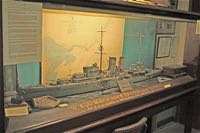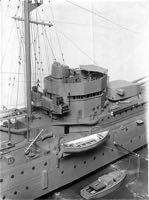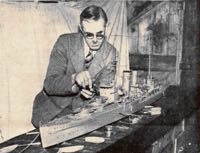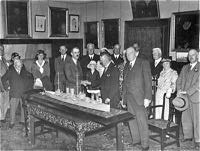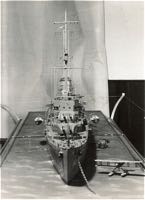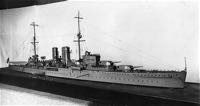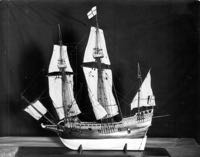
HMS Exeter - the model in the White Ensign Club
Page updated 9th November 2015
The forth HMS Exeter was launched on 18 July 1929, and the long tradition of pairing a Royal Navy ship with a town or city continued, when she was adopted by her namesake, the city of Exeter.
A local model maker Mr Ernest P G Oddy set about building a scale model of the York Class cruiser, sometime in late 1930 or early 1931. Oddy, who was a prolific and skilled model maker, lived in Barnfield Road and Beacon Lane. It took him 15 months to craft the one-eighth scale model, using blue prints loaned to him by the Admiralty, supplemented by sketches and photographs taken by Mr Oddy when he, on several occasions, visited the ship in Devonport and during her visit to Exmouth in July 1931. Captain Gibson (later Rear Admiral Worsley Gibson) gave Oddy every assistance in making the model. Mayor Charles Warren was responsible for persuading the Admiralty to allow the blue prints to be released to Mr Oddy.
The hull is carved from oak, while the superstructure is mostly brass and copper. The model shows the cruiser as lying at anchor, and flying the captain’s pennant. Her boat booms are out, complete with sea ladders, along with a motor pinnace floating next to one of the ladders. There are two miniature whalers, a motor pinnace, a pinnace, gig and two life-cutters, all perfectly matched to the main ship.
Other features of the model were her miniature 8in guns, two Fairey seaplanes mounted on their catapults, one ready for launching. An example of the thoroughness of Mr Oddy is shown by the ship’s bell, which has the ship’s name engraved in letters so small that they can be scarcely seen.
The model was first shown at the Recorder’s dinner in the Guildhall on the 3 October 1932. The model went on show to the public during the Exeter Festival Week in June 1933, when it was in Mark Rowe’s arcade window, in the High Street. The model was loaned by Mr Oddy, as the model was still his property. The next time the model was on show was in February 1934 at No 16 The Close (now the Wellhouse), along with models of earlier HMS Exeter's, all constructed by Mr Oddy. It was during this exhibition that it was suggested the model be purchased by the city.
On 7 June 1934, the Mayor was officially presented with the model in the Mayor’s Parlour at the Guildhall. Mr Gatey along with Mr C J Ross, Mr Douglas Bruford—who had organised the fund—and others had subscribed to purchase the model from Mr Oddy, and compensate him for the two years of research and construction of the model.
Damaged by the public
The model was put on permanent exhibition at Rougemont House, then part of the museum. WIthin a month it had been badly damaged by souvenir hunters who had removed some of the small boats. One of the aircraft catapults had been trodden on, and accommodation ladders damaged while chain stoppers and wheel blocks disappeared.
Mr Oddy stated "This is not how the citizens of Exeter would handle a treasure of their very own.. The two years I have put into the model is now almost completely ruined by souvenir-hunters and meddlesome children... Something—a glass case or a guard—should be provided to protect it until the time comes for it to be moved to its proper position in the Museum."
The model was put into storage and forgotten. After HMS Exeter was involved in the Battle of the River Plate, thoughts returned to the model—Mr Oddy was called back to repair the model for display. When the Captain and crew visited the city in February 1940, not only was there the model of Exeter, but there was a partly finished model of the Graf Spee. Mr Oddy said he was in the process of building models of HMS Ajax and HMS Achilles, the other ships engaged in the battle.
The model remained on show, in a glass case, at the Guildhall through the war, and many visiting US troops were known to have visited the exhibit. After the war the model was on show in the Guildhall, although the lack of a permanent space meant that it often had to be moved for Assizes, or other functions. After a brief return to the museum, in 1969, the model was loaned to the newly opened Maritime Museum, at the city basin. The model of the Exeter was loaned to the White Ensign Club in 1980, for display in their new club house, Trinity Church in South Street, where it can be seen today.
Ernest Oddy worked as a press photographer in the 1920s and early 30s. He then joined the Co-op Dairy until war broke out. During the war, he was a full time air raid warden for Whipton. He also made models of anti-personnel bombs, for use in training. After the war, Mr Oddy became involved in the Starcross Yacht Club as the flag captain. He continued to make models, and was brought back for running repairs to the model of HMS Exeter, from time to time. When the Type 42 Destroyer, HMS Exeter was launched in1978, he announced that he was to make a model of City's newly adopted ship.
Source: The British Newspaper Archive. Newspaper clippings, letters and other memorabilia from David Oddy.
│ Top of Page │
